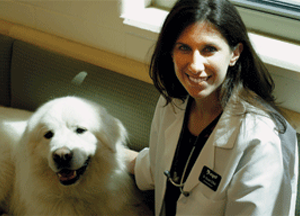-
Adopt
-
Veterinary Care
Services
Client Information
- What to Expect – Angell Boston
- Client Rights and Responsibilities
- Payments / Financial Assistance
- Pharmacy
- Client Policies
- Our Doctors
- Grief Support / Counseling
- Directions and Parking
- Helpful “How-to” Pet Care
Online Payments
Referrals
- Referral Forms/Contact
- Direct Connect
- Referring Veterinarian Portal
- Clinical Articles
- Partners in Care Newsletter
CE, Internships & Alumni Info
CE Seminar Schedule
Emergency: Boston
Emergency: Waltham
Poison Control Hotline
-
Programs & Resources
- Careers
-
Donate Now
 Susan O’Bell, DVM, MPH, DACVIM
Susan O’Bell, DVM, MPH, DACVIM
angell.org/generalmedicine
generalmedicine@angell.org
617-522-7282
Few events in life are as exciting as welcoming a new canine or feline companion to your household. Like most things, however, this transition will be smoother with preparation. Great places to focus your attention and preparation are:
- How to select the best pet for your family
- Setting appropriate expectations of what is normal animal behavior and how the human members of the household should behave. Obviously parenting techniques vary from one family to the next, but if you are adding a cat or a dog to your family and there are any children with whom the pet may be interacting, I suggest modeling behavior for the children, “practicing” with their stuffed animals, and considering “time outs” or some form of restricted access to the pets if the children aren’t following your rules. I recommend this for the safety of the pets and family members.
Most importantly, do not leave children unsupervised with pets.
 This may sound too strict for some, but during an introductory period, there is a steep learning curve for humans and pets alike. All new pets experience some level of stress adjusting to a new home, just how much stress and how this may manifest as certain behaviors is highly variable from one animal to the next. This may be your very first experience living with and caring for a cat or dog. Be patient! It can take a long time to learn how to interpret behavioral cues from animals. Dogs don’t necessarily appreciate the same kinds of affection that humans are used to sharing between humans. Children and adults alike may not realize that hugs, face touching, loud laughter, boisterous body language, and sharing food and toys are not always well received. Do you know someone who has been bitten by a dog, or have you been bitten yourself? A staggering 4.5 million people are bitten by dogs each year in the United States, and children by far are the most likely to be bitten, and to be bitten severely. Most bites occur during everyday activities and while interacting with familiar dogs.
This may sound too strict for some, but during an introductory period, there is a steep learning curve for humans and pets alike. All new pets experience some level of stress adjusting to a new home, just how much stress and how this may manifest as certain behaviors is highly variable from one animal to the next. This may be your very first experience living with and caring for a cat or dog. Be patient! It can take a long time to learn how to interpret behavioral cues from animals. Dogs don’t necessarily appreciate the same kinds of affection that humans are used to sharing between humans. Children and adults alike may not realize that hugs, face touching, loud laughter, boisterous body language, and sharing food and toys are not always well received. Do you know someone who has been bitten by a dog, or have you been bitten yourself? A staggering 4.5 million people are bitten by dogs each year in the United States, and children by far are the most likely to be bitten, and to be bitten severely. Most bites occur during everyday activities and while interacting with familiar dogs.
What can make the introduction of a new pet to the household smoother and more likely to succeed?
 Think about your lifestyle as it is now and how a pet will fit into this lifestyle. Be realistic. (Your Pinterest boards might portray you as a globe trekking, exercise fanatic who owns every William Wegman book that has been published, but in reality, you may prefer a couch potato lifestyle, so a Weimaraner would be the worst possible dog you could acquire!)
Think about your lifestyle as it is now and how a pet will fit into this lifestyle. Be realistic. (Your Pinterest boards might portray you as a globe trekking, exercise fanatic who owns every William Wegman book that has been published, but in reality, you may prefer a couch potato lifestyle, so a Weimaraner would be the worst possible dog you could acquire!)
Educate yourself on what type of dog or cat will be a good match for you. When I am educating my clients about selecting their next cat or dog, I stress being fair to themselves and their families. Yes, support your local shelters, but don’t visit the shelter without a clear plan in mind. You should already have identified resources for feeding, walking, doggie daycare, what you will do when you travel, routine and emergency medical care funds/pet insurance, and have a commitment from everyone in the household to the care of the new pet. Rely on your veterinarian, local behaviorists, family members and friends with pets as resources for realistic time and financial commitments that go along with pet ownership.
Set the ground rules with your children before you set foot in a shelter: no unsupervised play; let the dog or cat approach you; don’t chase them; most animals don’t like to be hugged; pick a dog or cat from the shelter that shows clear interest in and approaches your children, not the other way around.
Here I have highlighted what I would consider some important DOs and DON’Ts when it comes to introducing your new pet to your household:
- DO find out what type of food and treats the pet has already been eating. Even if you plan on a diet change, I recommend consulting with your veterinarian before making the transition, and in an ideal world, continue feeding what they have already been eating. Transitioning to a new home can be stressful, and often stress manifests as gastrointestinal upset in dogs and decreased (or complete lack of) appetite in cats. If this occurs, call your veterinarian right away for guidance.
- DO have a place for your new dog to sleep – at least a bed and better yet a crate.
- DO have at least two hiding places for your new cat – even a cardboard box with a towel over it will do the trick! Cats often like perches or high places to get away ‑ see if you can work this into your living space.
- DO identify a safe way to transport them to and from your home; I do not recommend letting dogs or cats have free reign of the car. This could be a very unsafe situation especially not knowing the behavior of the new pet well enough yet.
- DO have a form of identification (collars, tags, microchip information, etc.).
- DO have a veterinary hospital identified for routine care and schedule an appointment at some point within the first few weeks of acquiring your new pet.
- DO have the information for your nearest 24-hour emergency hospital and poison control clearly posted and/or saved in your phone.
- DO set up a safe dog or cat “proofed” room in the house; crawl around at ground level to look for hidden dangers such as electrical cords, loose change, potentially toxic plants, etc.
- DO identify obedience class for your new dog even if you consider yourself a “seasoned” dog owner and plan on the entire family participating.
- DO identify local, qualified, behavioral resources so that you have support for any issues that arise with your new cat or dog before they get out of hand (yes, some undesirable behaviors may be due to the stress of a new home, however it is better to work on these small problems right away rather than wait for them to become even bigger problems).
If you already have resident cat(s)/dog(s):
- DO consider your resident cat/dog before acquiring another pet; consider consulting your veterinarian as well as a qualified behaviorist to help you figure out if your current dog or cat would thrive or do poorly with a new cat or dog .
- DO make sure your pet is physically healthy and up to date on all vaccines and preventative medications.
- DO discuss with your veterinarian the upcoming addition so he or she can serve as a resource for any steps you should take to ease the transition.
- DO introduce dogs on neutral territory and keep them both leashed until each dog’s behavior is predictable.
- DO keep cats separated in different parts of the house. After a few days you can place a towel with the scent of one pet in the other’s room. Eventually move the cats to rooms that are next to one another but keep them on opposite sides of a closed door. Try feeding them on separate sides of the door but back off if you see signs of fear or anger. Once you have worked up to letting the cats see one another, make sure each cat has a safe escape route.
- DON’T intervene if there is a fight. It’s possible one or more pets may end up needing medical attention, but don’t put yourself at risk for serious injury.
Chances are everyone will be living in harmony, whether you are single with a single cat or dog, or adding another pet to a household full of people and a resident cat and/or dog. Do the necessary prep work to improve those chances greatly, and call your veterinarian and local behaviorist if you suspect any issues before or after your new pet has joined your family.
For information about Angell’s behaviorist, Dr. Terri Bright, dog training class schedules, or individual behavior consults for cats or dog, visit www.angell.org/behavior. Here are two great websites recommended by Dr. Bright:
- dogsandbabieslearning.com
- doggonesafe.com (dog bite prevention)